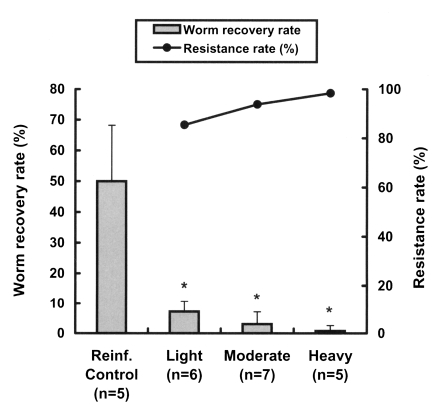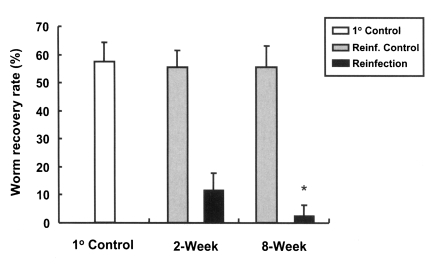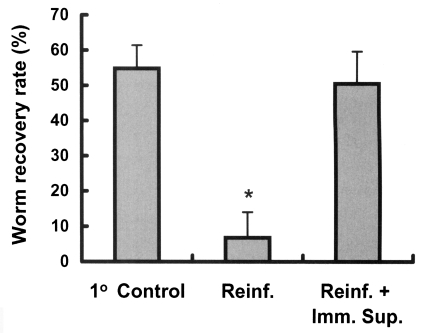INTRODUCTION
The Chinese liver fluke,
Clonorchis sinensis, is widely distributed in Korea, China, East Russia and Vietnam, in regions where residents eat raw or undercooked freshwater fish carrying
C. sinensis (
Crompton, 1999). The adult fluke inhabits the biliary passages of humans and mammals, and provokes epithelial hyperplasia of the biliary mucosa and periductal fibrosis. Frequent symptoms of human clonorchiasis are a dull epigastric fullness or pain, mild fever, loss of appetite, diarrhea, and jaundice. Moreover, clonorchiasis has been proven epidemiologically and experimentally to be associated with cholangiocarcinoma (
Rim, 1986;
Chen et al., 1994;
Lee et al., 1997;
Watanapa and Watanapa, 2002).
Epidemiological studies suggest that humans do not develop any resistance to reinfection or superinfection by
C. sinensis, and that reinfection readily occurs upon re-exposure throughout life in those accustomed to consuming undercooked fish in endemic areas (
Seo et al., 1981;
Hong et al., 1994). However, persons in schistosomiasis endemic areas have been shown to express different levels of resistance to reinfection (
Hagan et al., 1991;
Caldas et al., 2000). In addition, hamsters have been reported to be resistant to reinfection by
Opisthorchis viverrini (
Flavell, 1982) and rats were found to be resistant to reinfection by
Fasciola hepatica or
Schistosoma mansoni. Moreover, in the rat the mechanism of this resistance was found to be related to the development of acquired immunity in the host (
Doy et al., 1978;
Cetre et al., 1999). Protective immunity has been suggested in rats reinfected with
C. sinensis (
Quan et al., 2000), however, there is no clear evidence of resistance to reinfection by
C. sinensis so far. Therefore, we undertook this study to observe whether exposure to clonorchiasis develops resistance to reinfection in experimental animals. Resistance was further evaluated according to the intensity and duration of the primary infection in rats, and the potential effect of this developed resistance was examined to determine its consequences on worm development in reinfected rats. Rats were also immunosuppressed to determine whether immunity plays a role in resistance to
C. sinensis reinfection.
DISCUSSION
By using the worm recovery rate as a measure of resistance to reinfection, the present study demonstrates for the first time that rats do develop resistance to C. sinensis reinfection. Primary infected rats had a worm recovery rate of more than 50%; however, almost no worms were recovered when they were rechallenged with the same number of metacercariae after the primary infection had been cleared by praziquantel treatment. Worm development was also significantly impaired at reinfection. These findings suggest that the development of acquired protection in rats is the result of pre-exposure to C. sinensis.
However, hamsters failed to develop reinfection resistance, and neither did rabbits (data not shown). Moreover, results on resistance to reinfection in hamsters infected with
O. viverrini, another liver fluke closely related with
C. sinensis, are controversial (
Flavell, 1982;
Sirisinha et al., 1983). Flavell (
1982) reported that hamsters acquire resistance to
O. viverrini, and that this results in a significant worm burden reduction (
Flavell, 1982), suggesting that prior infection results in a significant reduction in the faecal egg during a subsequent infection. On the other hand, Sirisinha et al. (
1983) demonstrated that a prior infection failed to induce significant protection against reinfection by
O. viverrini in hamsters (
Sirisinha et al., 1983). A lack of protection was also noted in animals reinfected or superinfected several times with small doses of metacercariae. Thus it is possible that hamsters possess different defense mechanism against
C. sinensis or
O. viverrini.
In the present study, the mechanism underlying the high resistance to
C. sinensis reinfection shown by rats is not clear. However, some observations made during this study suggest the involvement of immune responses in this resistance to reinfection. The resistance rate was found to be weakly related to the intensity of the primary infection (
Fig. 2), but this increased when the duration of the primary infection was prolonged sufficiently to allow the worms to mature to the adult stage during the primary infection (
Fig. 3). Moreover, resistance to reinfection was substantially suppressed by methylprednisolone (
Fig. 4, Table 5), providing further evidence that the resistance may have been due to acquired immunity induced by the primary infection.
Acquired immunity is been known to be closely related with resistance to reinfection by
S. mansoni and
F. hepatica in rats (
Doy et al., 1978;
Cetre et al., 1999). After a primary infection, rats develop a strong immunity-mediated resistance to
S. mansoni reinfection. Studies have implicated different immune mechanisms, including anaphylactic antibodies (IgE) and non-lymphoid cells, such as eosinophils, macrophages, and platelets, in the rejection of worms between 3 and 4 weeks after a primary infection, and in the development of immunity to superinfection by schistosomes (
Capron and Capron, 1986;
Khalife et al., 2000). In rat schistosomiasis, a Th2 response was found to benefit the host, and to result in protective immune responses and resistance to reinfection (
Cetre et al., 1999). However, this finding is in contrast to observations in a murine model, in which Th2 responses were associated with pathology (
Khalife et al., 2000).
In case of
F. hepatica, resistance to reinfection in rats is known to occur within 48 hr of challenge, and appears to function at the intestine or body cavity (
Doy et al., 1978;
Burden et al., 1983). Moreover, acquired resistance has been shown to be associated with anaphylaxis and eosinophilic infiltration of the intestine; eosinophils adhere to newly excysted juveniles of
F. hepatica and damage the tegument, when injected intraperitoneally into sensitized rats. However, the mechanism of resistance to
C. sinensis may differ from those to
F. hepatica and
S. mansoni, because of different metacercariae migration patterns in the final hosts in the case of
F. hepatica, and because of a different pathogenetic mechanism in the case of
S. mansoni.
Recently, strain differences have been reported in mice in terms of their susceptibility to
C. sinensis infection (
Yoon et al., 2001). FVB/NJ mice were found to be susceptible and BALB/c mice relatively resistant to clonorchiasis (
Yoon et al., 2001); moreover, Th2 cytokine response, especially IL-4 production, was associated with the susceptibility to
C. sinensis infection (
Choi et al., 2003). This suggests that mice may show strain dependent resistance patterns, and that Th2 cytokine response may be associated with resistance to
C. sinensis reinfection. In this respect, mice and rats could be useful animal models for investigations of resistance mechanisms to
C. sinensis infection.
In the present study, resistance to reinfection was reflected by the delayed development of
C. sinensis in reinfected rats, and by a lower worm recovery rate. This contradicts to some extent the findings of Talvik et al. (
1998), that challenge by
Oesophagostomum quadrispinulatum in pigs produced a lower worm burden, but no apparent stunting and no reduction in fecundity (
Talvik et al., 1998). However, suppressed larval development has been observed following repeated infections with Oesophagostomum spp. in pigs (
Kendall et al., 1977).
The present study shows that rats developed high levels of resistance to reinfection after clearance of the primary infection, and that this resistance can be substantially impaired by immunosuppression, which suggests the potential role of host immunity in the development of resistance to reinfection. However, the precise nature of the mechanism of this resistance to reinfection requires further investigation. The elucidation of this mechanism would enhance our understanding of the parasite-host relationship, and facilitate the development of effective vaccines for clonorchiasis.





